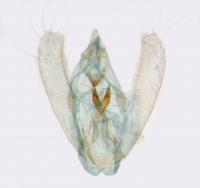|
Field Guide Descriptions: | Online Photographs: MPG, BugGuide, GBIF, BOLD | Technical Description, Adults: Forbes (1948) | Technical Description, Immature Stages: Wagner et al. (2001) | |
| Adult Markings: A medium-small, pale yellowish-white Geometrid. The ground color of the forewings, as well as the head and body, is cream colored. The overall orange dusting in all but well-worn specimens is characteristic, usually forming three to four transverse bands. This species is apt to be confused with species of Cabera and maybe even Scopula. A black discal spot and brown postmedial spots on the undersides of the wings can be used to distinguish this species from Cabera (Forbes, 1948). |
| Wingspan: 25 mm (Forbes, 1948) |
| Adult Structural Features: Male antennae are simple rather than pectinate as they are in Cabera. Worn females may need to be determined by venation differences or by dissection. Both males and females have distinct genitalia, which should easily separate them from similar species. |
| Structural photos |

Male reproductive structures. Specimen collected April 29, 2016, Ashe County, by J.B. Sullivan. |

Aedeagus. Specimen collected April 29, 2016, Ashe County, by J.B. Sullivan. |

Female reproductive structures. Specimen collected July 17, 1998, Jones County, by J.B. Sullivan. |

Abdominal pelt. |
|
| Adult ID Requirements: Identifiable from good quality photos of unworn specimens. |
| Immatures and Development: Caterpillars are rather nondescript but with multiple longitudinal lines. Abdominal segments narrowed anteriorly (see Wagner et al., 2001 for an illustration and more detailed description) |
| Larvae ID Requirements: Identifiable from good quality photos, especially where associated with known host plants. |